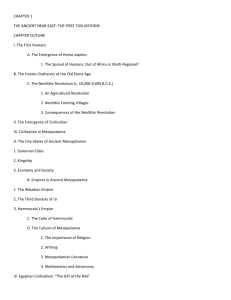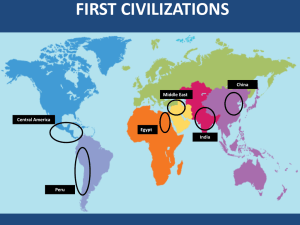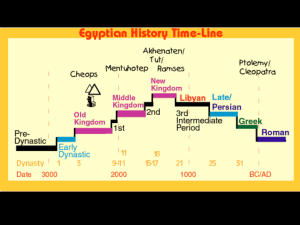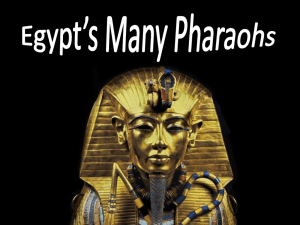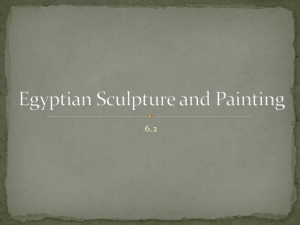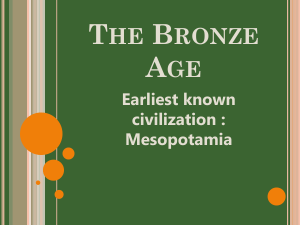Chapter 1.2- Western Asia & Egypt
advertisement
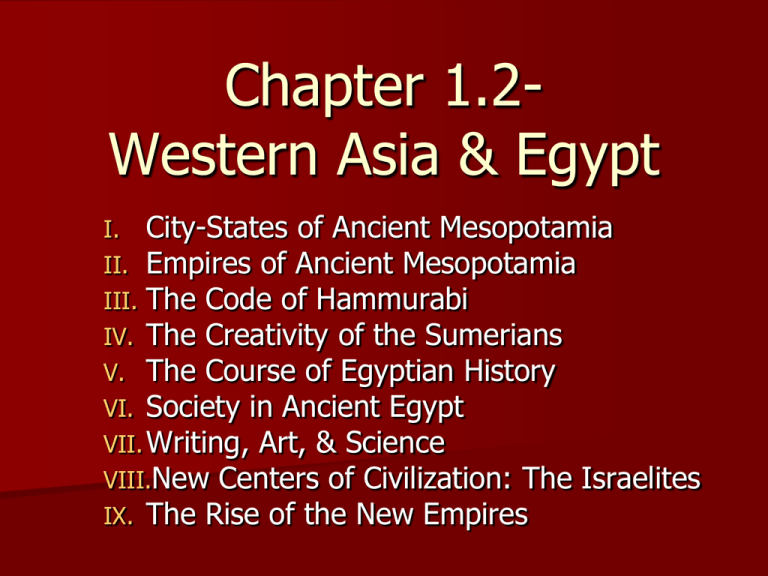
Chapter 1.2Western Asia & Egypt I. City-States of Ancient Mesopotamia II. Empires of Ancient Mesopotamia III. The Code of Hammurabi IV. The Creativity of the Sumerians V. The Course of Egyptian History VI. Society in Ancient Egypt VII. Writing, Art, & Science VIII.New Centers of Civilization: The Israelites IX. The Rise of the New Empires The City-States of Ancient Mesopotamia The valley between the Tigris and Euphrates Rivers is part of the Fertile Crescent, an arc of land extending from the Mediterranean Sea to the Persian Gulf – Through a large-scale system of water control, crops could be grown on a regular basis, enabling large numbers of people to live together in cities. The City-States of Ancient Mesopotamia The first city-states in Mesopotamia were created by the Sumerians – These states controlled the surrounding countryside politically and economically – The most prominent building in a Sumerian city was the temple – The people devoted much of their wealth to building temples providing elaborate houses for the priests and priestesses – Power passed from religious leaders to kings – Kings led armies and organized the water control projects necessary to sustain farming Empires in Ancient Mesopotamia City-states fought for control of land and water – The flat land of Mesopotamia encouraged invasion by outside groups – Sargon, leader of the Akkadians, overran the Sumerian city-states in 2340 B.C. and set up the first empire in history – An empire is a large political unit that controls many peoples and territories – In 1792 B.C., Hammurabi of Babylon established a new empire over much of Akkad and Sumeria The Code of Hammurabi Hammurabi is known for his law code, a collection of 282 laws – Penalties were severe They varied according to social status based on the principle of retaliation. The law code contained consumer protection laws to encourage the proper performance of work – The largest group of laws dealt with marriage and the family Parents arranged marriages, and the two parties signed a marriage contract – The law code expressed the patriarchal nature of Mesopotamian society Women had fewer privileges and rights than men The code also enforced the obedience of children to parents The Creativity of the Sumerians The Sumerians created a system of writing called cuneiform (wedge-shaped) – They used a reed stylus to make wedge-shaped marks on clay tablets, which were then baked in the sun Writing was used to keep records and to pass on knowledge – It allowed people to communicate in new ways – The Epic of Gilgamesh is an important Mesopotamian epic poem The Creativity of the Sumerians The Sumerians invented important items – – – – – the wagon wheel the potter’s wheel the sundial the arch bronze The Sumerians developed a number system based on 60. Geometry was used to measure fields, and the Sumerians charted the constellations The Course of Egyptian History The Nile is the longest river in the world – The area where the Nile splits in two, before it empties into the Mediterranean, is called the Nile delta, also called Lower Egypt – The land upstream is Upper Egypt Egyptian history is divided into three major periods of stability, peace, and cultural activity: – the Old Kingdom – the Middle Kingdom – the New Kingdom Between the periods of stability were ages of political chaos and invasion The Course of Egyptian History Egyptian history began around 3100 B.C. when King Menes united Upper and Lower Egypt into a single kingdom – He created the first dynasty in Egypt A dynasty is a family of rulers whose right to rule is passed on within the family During the prosperous Old Kingdom, 2700–2200 B.C., Egyptian rulers became known as pharaohs, which means “great house” or “palace.” The Course of Egyptian History The pyramids were built during the Old Kingdom – Pyramids were tombs for the mummified bodies of the pharaohs – Priests performed the process of mummification, which could last 70 days The largest pyramid is the Great Pyramid of King Khufu at Giza – Built around 2540 B.C. – it stands next to a huge statue with the body of a lion and the head of a man Known as the Great Sphinx, it is believed to bear the likeness of Khufu’s son Khafre The Course of Egyptian History The Middle Kingdom, 2050–1652 B.C., was later portrayed by Egyptians as a golden age of stability – pharaohs displayed a new concern for the people – pharaohs undertook public works such as draining swampland to provide more farming land The Middle Kingdom came to an end when the Hyksos invaded from western Asia – The Hyksos had horse-drawn chariots and superior bronze weapons The Course of Egyptian History The conquered Egyptians eventually drove out the Hyksos and established the New Kingdom from 1567–1085 B.C. – Egypt became a militaristic and powerful state – Massive wealth was used to enhance the prestige and power of the pharaohs – Many new temples were constructed. Invasions by a group known as the “Sea Peoples” eventually caused the loss of the Egyptian Empire. For the next thousand years, Libyans, Nubians, Persians, and Macedonians dominated Egypt. Society in Ancient Egypt Egyptian society was organized like a pyramid – The pharaoh was at the top – He was surrounded by a ruling class of nobles and priests They ran the government and managed their own estates – Below the upper class were merchants, artisans, scribes, and tax collectors Artisans created beautiful goods that merchants sold – The largest number of people in Egypt were peasants who worked the land, paid taxes, and provided military service and labor Writing, Art, and Science Writing emerged in Egypt around 3000 B.C Egyptians used a system called hieroglyphics. – It used pictures and abstract forms and was written on temple walls and tombs – A simplified version, written on papyrus, is called hieratic script used for business transactions and the general needs of everyday life Writing, Art, and Science Pyramids, temples, and other monuments exemplify the architectural and artistic achievements of the Egyptians – Artists followed a distinctive style the human body was often shown as a combination of profile, semi-profile, and frontal view in order to accurately represent each part – To erect their monumental building projects and accurately survey their flooded land, Egyptians made important advances in geometry They were able to calculate area and volume New Centers of Civilization: The Israelites As Mesopotamian and Egyptian civilizations declined, smaller states emerged – The Israelites were a Semitic people who lived in Palestine emerged as a distinct group between 1200–1000 B.C. who established a united kingdom known as Israel New Centers of Civilization: The Israelites King Solomon, who ruled from about 970 to 930 B.C., expanded the government, army, and trade. – He built a temple in Jerusalem – Under Solomon, ancient Israel was at the height of its power. New Centers of Civilization: The Israelites After Solomon’s death, Israel divided into two kingdoms – The northern kingdom was Israel – the southern kingdom was Judah This kingdom gave its name to the religion of the Israelites, Judaism The Jews were monotheistic They worshipped one god, Yahweh New Centers of Civilization: The Israelites The covenant, law, and prophets were three aspects of Jewish religion – The covenant, or contract, was the agreement between God and his people: Yahweh promised to guide them if they obeyed the law of God stated in the Ten Commandments – Prophets were sent by God to serve as his voice to the people expressed concern for all humanity and the hope that all people would someday follow the God of Israel, and peace would be established – Prophets were concerned for social justice They called on the Jews to act justly, share with neighbors, care for the poor and unfortunate, and act with compassion The Rise of New Empires The independent state of Israel was conquered by larger empires Through the use of iron weapons and military conquest, the Assyrians established an empire by 700 B.C. – used terror as an instrument of warfare – regularly destroyed the land in which they were fighting – Internal strife and resentment of Assyrian rule brought about the collapse of the empire in 612 B.C. The Rise of New Empires The Persians were a nomadic, Indo-European people living in what today is southwestern Iran – One family unified the various groups – One member, Cyrus, created a powerful Persian state from Asia Minor to western India. Cyrus ruled from 559 to 530 B.C. He captured Babylon, treating his subjects with wisdom and restraint, and he allowed the Jews to return to Jerusalem The Rise of New Empires Darius, who ruled from 521 to 486 B.C., extended the empire into India and Europe, creating the largest empire the world had yet seen Efficient communication was necessary to sustain the Persian Empire. – The Royal Road, stretching from Lydia to Susa, linked the empire – The Persians set up way stations providing rest, shelter, and fresh horses for the king’s messengers. After Darius, the Persian kings became more isolated in their luxurious courts. Struggles over power weakened the empire until it was conquered by Alexander the Great during the 330s B.C. Washington Monument Great Pyramid of King Khufu Click the mouse button or press the Space Bar to display the answers. 415 feet or 127 meters

